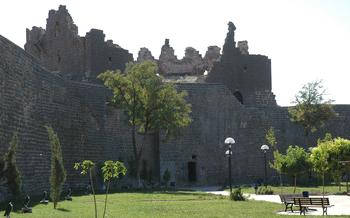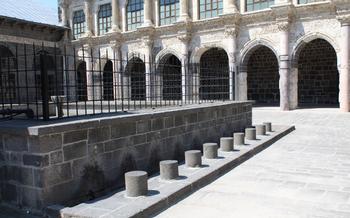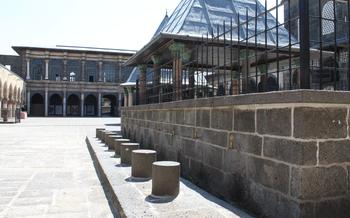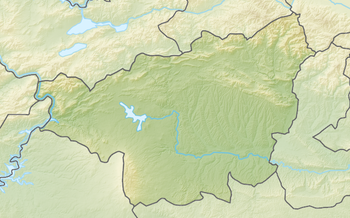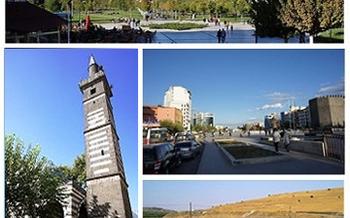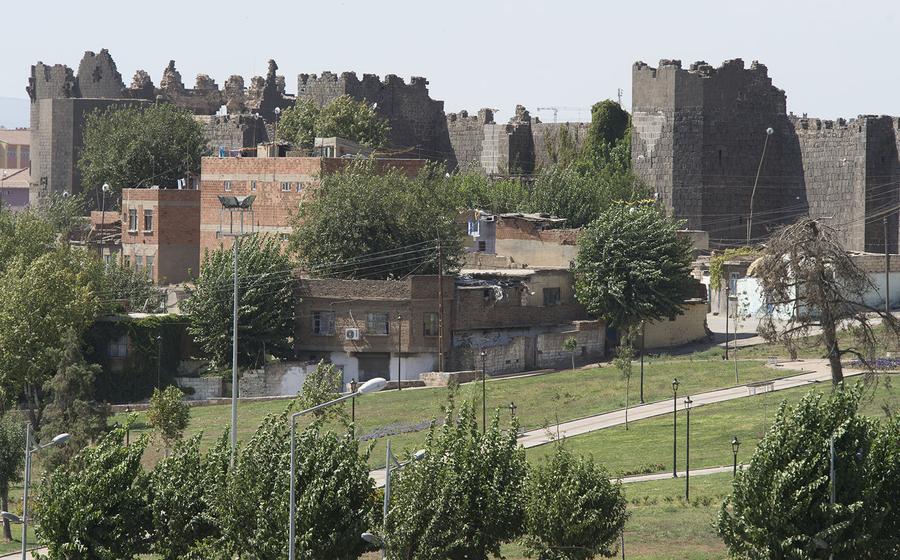
Mardin Gate
- Historical Significance
- Architectural Marvel
- Cultural Heritage
- Restoration and Preservation
- Nearby Attractions
- Local Cuisine
- Local Crafts and Handicrafts
- Photography Opportunities
- Historical Reenactments
- Guided Tours
- Accessibility
- Safety and Security
- Insider Tip: Unveiling Diyarbakır's Hidden Treasures
Historical Significance
The Mardin Gate, a majestic relic of antiquity, stands as a testament to Diyarbakır's rich and storied past. Dating back to the Roman era, this gate has played a pivotal role in the city's defense, serving as a strategic entry point and a formidable barrier against invaders. Over the centuries, various civilizations have left their indelible mark on the gate's architecture, creating a unique blend of Roman, Byzantine, and Islamic styles. Its name, Mardin Gate, reflects its orientation towards the ancient city of Mardin, located to the south of Diyarbakır. This gate has witnessed countless historical events, silent yet steadfast, a guardian of Diyarbakır's legacy.
Architectural Marvel
The Mardin Gate stands as a testament to the architectural prowess of ancient civilizations. Constructed with remarkable precision and durability, the gate's sturdy walls have withstood the ravages of time and countless historical events. Its imposing structure, adorned with intricate carvings and embellishments, reflects a harmonious blend of Roman, Byzantine, and Islamic architectural influences.
The gate's arched entrance, flanked by imposing towers, creates a dramatic and awe-inspiring sight. The towers, with their strategic positioning and arrow slits, served as defensive fortifications, protecting the city from potential invaders. The gate's elaborate carvings, showcasing geometric patterns, floral motifs, and symbolic figures, demonstrate the exceptional craftsmanship and artistry of the builders.
Each detail of the Mardin Gate's architecture holds significance. The decorative elements, including inscriptions and friezes, narrate stories from history and mythology, offering glimpses into the rich cultural heritage of Diyarbakır. The gate's sturdy construction testifies to the engineering prowess of ancient civilizations, showcasing their ability to create structures that have endured for centuries.
Cultural Heritage
The Mardin Gate holds a profound significance as a symbol of Diyarbakır's rich cultural heritage. Its enduring presence has woven it into the fabric of local folklore, legends, and traditions, becoming an integral part of the city's collective memory. Stories and tales have been passed down through generations, each adding a layer of enchantment to the gate's mystique. Artists, writers, and musicians have found inspiration in its grandeur, capturing its essence in paintings, poems, and songs. The gate has become a symbol of resilience, standing as a testament to Diyarbakır's ability to preserve its cultural identity amidst the passage of time and the rise and fall of empires. It is a living reminder of the city's rich past and a source of pride for its people.
Restoration and Preservation
Over the centuries, the Mardin Gate has undergone several restoration and preservation efforts to maintain its structural integrity and historical significance. In the early 20th century, the gate was in a state of disrepair due to neglect and the effects of time. Recognizing its importance, the Turkish government initiated a comprehensive restoration project in the 1960s. This project involved meticulous cleaning, repair of damaged sections, and reinforcement of the gate's foundations.
One of the main challenges in restoring the gate was balancing the need for preservation with accessibility. The gate's original design did not accommodate modern accessibility standards, making it difficult for visitors with disabilities to navigate. To address this, ramps and elevators were strategically added without compromising the gate's architectural integrity.
The restoration efforts also focused on preserving the gate's unique decorative elements and inscriptions. Skilled artisans and craftsmen were employed to restore the intricate carvings and calligraphy that adorn the gate's façade. This meticulous attention to detail ensured that the gate's original splendor was retained while enhancing its accessibility for all visitors.
Today, the Mardin Gate stands as a testament to the successful collaboration between preservationists, architects, and historians. It serves as a living reminder of Diyarbakır's rich past and continues to be a symbol of the city's resilience and cultural heritage. Ongoing maintenance and preservation efforts ensure that the gate remains a source of pride for the people of Diyarbakır and a must-visit destination for travelers seeking to explore the city's historical wonders.
Nearby Attractions
In addition to the Mardin Gate, Diyarbakır offers a wealth of nearby attractions that visitors can explore to gain a deeper understanding of the city's rich history and culture. The Diyarbakır Fortress, a UNESCO World Heritage Site, is a must-see for history buffs. With its imposing walls and towers, the fortress provides a glimpse into the city's past as a strategic military stronghold.
For those interested in Islamic architecture, the Great Mosque of Diyarbakır is a stunning example of Seljuk architecture. Built in the 11th century, the mosque features intricate carvings and a beautiful courtyard. The Church of the Virgin Mary, also known as the Mor Behnam Church, is another architectural marvel that showcases the city's Christian heritage.
Diyarbakır is also home to several museums that offer insights into the city's past and present. The Diyarbakır Museum houses a vast collection of artifacts from the region, including ancient pottery, jewelry, and manuscripts. The Ziya Gökalp Museum is dedicated to the life and works of the famous Turkish poet and sociologist Ziya Gökalp.
Visitors can enhance their understanding of Diyarbakır's culture by exploring the city's traditional bazaars. The Coppersmiths' Bazaar is a vibrant marketplace where visitors can witness the artisans creating beautiful copperware. The Spice Bazaar offers a sensory overload with its colorful array of spices, herbs, and traditional Turkish delights.
To experience the city's vibrant culinary scene, visitors can head to the On Gözlü Köprü (Ten-Eyed Bridge), a historic bridge lined with restaurants serving traditional Diyarbakır cuisine. Visitors can indulge in local specialties such as mumbar dolması (stuffed intestines), ciğer kebabı (liver kebab), and Diyarbakır karpuzu (watermelon).
A suggested itinerary for visitors who want to explore Diyarbakır in-depth could include:
Day 1:
- Morning: Visit the Mardin Gate and the Diyarbakır Fortress.
- Afternoon: Explore the Great Mosque of Diyarbakır and the Church of the Virgin Mary.
- Evening: Enjoy a traditional Diyarbakır dinner at On Gözlü Köprü.
Day 2:
- Morning: Visit the Diyarbakır Museum and the Ziya Gökalp Museum.
- Afternoon: Shop for souvenirs at the Coppersmiths' Bazaar and the Spice Bazaar.
- Evening: Attend a cultural performance at the Diyarbakır State Theater.
By following this itinerary, visitors can experience the best of what Diyarbakır has to offer, including its historical landmarks, cultural heritage, and culinary delights.
Local Cuisine
Diyarbakır's culinary scene is a vibrant tapestry of flavors and aromas, and the area surrounding the Mardin Gate is no exception. Visitors can indulge in a feast of local specialties, from savory kebabs to melt-in-your-mouth sweets.
One must-try dish is the "mumbar dolması", a delicacy made from lamb intestines stuffed with rice, spices, and herbs. The "çiğ köfte", a raw meatball dish, is another local favorite, known for its unique blend of flavors and textures.
For a taste of traditional Turkish cuisine, visitors can savor the "lahmacun", a thin, crispy flatbread topped with minced meat, vegetables, and spices. And no visit to Diyarbakır is complete without trying the "künefe", a sweet pastry filled with shredded filo dough, cheese, and syrup.
When it comes to restaurants, there are several options to choose from near the Mardin Gate. The "Mardin Kapı Restaurant" is a local favorite, known for its authentic Diyarbakır cuisine and warm hospitality.
For a more upscale dining experience, visitors can head to the "Diyarbakır Konağı Restaurant", which offers a refined take on traditional dishes in a stylish setting.
No matter where you choose to dine, be sure to embrace the local culinary culture and indulge in the delicious flavors that Diyarbakır has to offer.
Local Crafts and Handicrafts
Diyarbakır is renowned for its vibrant tradition of local crafts and handicrafts, which have been passed down through generations of skilled artisans. Near the Mardin Gate, visitors can find a treasure trove of shops and markets showcasing these unique creations.
One of the most popular crafts in Diyarbakır is copperware. Artisans skillfully shape copper into intricate decorative items, such as vases, trays, and lamps, using traditional techniques that have remained unchanged for centuries. The intricate designs and patterns on these copperware pieces are a testament to the artisans' mastery and creativity.
Another must-see craft in Diyarbakır is silver jewelry. Local artisans create exquisite jewelry pieces, such as necklaces, bracelets, and earrings, using high-quality silver. The designs often incorporate traditional motifs and symbols, making each piece a unique work of art.
Visitors can also find a variety of hand-woven textiles near the Mardin Gate. Skilled weavers use colorful threads to create beautiful rugs, carpets, and shawls. Each piece is a labor of love, showcasing the weavers' patience and precision.
When shopping for local crafts and handicrafts in Diyarbakır, be sure to visit the traditional bazaars and markets. These vibrant marketplaces offer a wide selection of handmade goods, allowing visitors to interact with the artisans and learn about their craft.
Remember, purchasing local crafts and handicrafts not only supports the talented artisans but also helps preserve the rich cultural heritage of Diyarbakır. So, take some time to explore the local shops and markets near the Mardin Gate and bring home a unique souvenir that will remind you of your travels in this historic city.
Photography Opportunities
The Mardin Gate is a photographer's paradise, offering a plethora of captivating angles and picturesque views. The gate's imposing stone facade, intricate carvings, and unique blend of architectural styles create a visually stunning subject for any photographer. The surrounding cityscape, with its bustling markets, narrow streets, and distant mountains, provides a dynamic backdrop for capturing the gate's grandeur.
The best time to photograph the gate is during the golden hours of sunrise and sunset, when the warm light casts a magical glow on the stonework and accentuates the intricate details of the carvings. To capture the gate's full majesty, use a wide-angle lens to encompass its imposing presence and the surrounding cityscape. Experiment with different perspectives by shooting from various angles, such as from the ground level to capture the gate's towering height or from a higher vantage point to showcase its panoramic setting.
For a truly unique perspective, venture onto the gate's ramparts, which offer breathtaking views of the city and the surrounding countryside. From this elevated position, you can capture panoramic shots that encompass the gate, the city walls, and the distant mountains, creating a stunning composition that encapsulates the essence of Diyarbakır.
Historical Reenactments
The Mardin Gate often serves as a backdrop for historical reenactments that bring the city's past to life. These immersive performances showcase significant events and stories from Diyarbakır's rich history, allowing visitors to experience the city's heritage in a unique and engaging way.
Reenactments typically take place during special occasions or festivals, such as the annual Diyarbakır Culture and Art Festival. During these events, the gate area transforms into a stage where actors dressed in period costumes recreate historical scenes, battles, and traditional ceremonies.
One of the most popular reenactments is the "Siege of Diyarbakır," which depicts the city's valiant defense against invading forces throughout history. Visitors can witness the clash of swords, the roar of cannons, and the resilience of the city's defenders as they relive this epic battle.
These historical reenactments offer an unforgettable experience that transports visitors back in time. They provide a deeper understanding of Diyarbakır's struggles, triumphs, and cultural traditions, making them a must-see for anyone interested in the city's history.
Guided Tours
To delve deeper into the gate's intriguing history and cultural significance, consider booking a guided tour. A knowledgeable guide can provide insights that you might miss on your own, especially if you're a first-time visitor. They'll regale you with tales of the gate's past, explaining its strategic importance, the various civilizations that have influenced its architecture, and the role it has played in local folklore and legends.
Guides can also point out intricate details and hidden gems that you might overlook, enhancing your understanding and appreciation of the gate. With their expertise, you'll gain a comprehensive perspective on this architectural marvel and its place in Diyarbakır's rich history.
To find reputable tour operators, check with your hotel concierge, the local tourism office, or online review platforms. Book your tour in advance to secure a spot, especially during peak tourist season. Whether you opt for a group tour or a private guided experience, you'll leave with a deeper understanding and appreciation for this iconic landmark.
Accessibility
The Mardin Gate is committed to ensuring that all visitors have a welcoming and accessible experience. The gate features ramps and designated parking spaces for individuals with disabilities. Additionally, the gate's staff is trained to assist visitors with any special needs or requirements. For those with visual impairments, audio guides are available to provide a comprehensive description of the gate's history and features. If you have any specific accessibility concerns or requests, please do not hesitate to contact the gate's management or consult the official website for more information. The gate strives to make its rich history and cultural significance accessible to everyone, and the staff is dedicated to providing the necessary support to ensure a memorable and inclusive visit for all.
Safety and Security
Diyarbakır is generally considered a safe city for tourists, and the Mardin Gate area is well-patrolled by security forces. However, as with any travel destination, it's essential to be aware of your surroundings and take necessary precautions. Avoid walking alone at night, be cautious of pickpockets in crowded areas, and keep your valuables secure. If you have any concerns or encounter any issues, don't hesitate to approach the local authorities or seek assistance from your hotel or tour operator. Remember, respecting local customs and traditions is crucial for a safe and respectful travel experience.
Insider Tip: Unveiling Diyarbakır's Hidden Treasures
Beyond the majestic Mardin Gate lies a treasure trove of hidden gems waiting to be discovered by curious travelers. Venture off the beaten path and explore the labyrinthine alleys of the old city, where ancient history whispers from every corner. Visit the majestic Diyarbakır Fortress, a UNESCO World Heritage Site, and marvel at its imposing walls and intricate carvings. Don't miss the Great Mosque of Diyarbakır, an architectural masterpiece that showcases the city's rich Islamic heritage. Immerse yourself in the vibrant local culture at the many traditional markets, where you can haggle for unique souvenirs and savor the tantalizing aromas of freshly prepared delicacies. Diyarbakır is a city that rewards those who wander aimlessly, so embrace the spirit of discovery and uncover its hidden treasures.


